Lobster fishing
.jpg)
Lobsters[Note 1] are widely fished around the world for their meat.[1] They are often hard to catch in large numbers, but their large size can make them a profitable catch.[1] Although the majority of the targeted species are tropical, the majority of the global catch is in temperate waters.[1]
Methods
Several methods are used to catch lobsters, with the method depending largely on the species being targeted.
Lobster pots
The large Homarus lobsters are caught almost exclusively with lobster pots (also called "lobster traps"). These are large rigid objects which the lobster enters voluntarily, often to reach bait, and which it then cannot escape.[2] Traps are also used in some spiny lobster fisheries, such as the fishery for the California spiny lobster, Panulirus interruptus, in the eastern Pacific Ocean.[3]
Trawling
Trawling is the main method used for the Norway lobster or Dublin Bay prawn, Nephrops norvegicus,[4] and for those slipper lobsters that prefer soft substrates, such as Thenus and Ibacus.[5] It has also become more frequently used in the fishery for Homarus americanus.[6]
Gill nets and trammel nets
Gill nets and trammel nets are used for the Caribbean spiny lobster, Panulirus argus.[7]
Hand-fishing and spearfishing
Slipper lobsters that prefer crevices, caves and reefs (including Scyllarides, Arctides and Parribacus species) are usually caught by SCUBA divers.[5]
Restrictions
Legal restrictions apply to the catching of lobsters in many parts of the world, in order to prevent overfishing and allow recruitment to the next generation. Common restrictions include the provision of a minimum landing size, preventing fishermen from catching "berried" females (females carrying eggs), closed seasons and limiting catches with individual fishing quotas.
Commercial fishing regulators in the United States, such as the Atlantic States Marine Fisheries Commission and the National Marine Fisheries Service, enforce restrictions through the use of lobster fishing licenses and lobster pot tags that correspond to the fisher's permit number. Tag manufacturers also maintain databases for each state's licensed fisheries, tracking how many tags each fisher purchases every year.[8]
Distribution and species
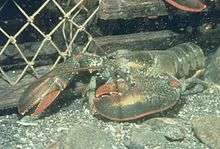
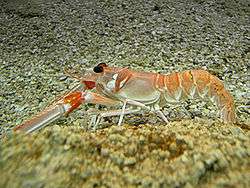
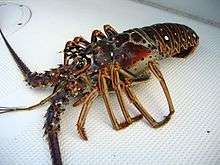
Of the 280,000 tons of lobster catches reported to the Food and Agriculture Organization for the year 2010, 188,000 t (67%) was of true lobsters (family Nephropidae), 80,000 t (28%) was of spiny lobsters (Palinuridae) and about 10,000 t (4%) was of slipper lobsters (Scyllaridae).[9]
| FAO common name | Scientific name | Catch in 2010 (t) [9] |
|---|---|---|
| American lobster | Homarus americanus | 115651 |
| Norway lobster | Nephrops norvegicus | 66544 |
| Caribbean spiny lobster | Panulirus argus | 35642 |
| Tropical spiny lobsters nei[Note 2] | Panulirus | 22128 |
| Japanese fan lobster | Ibacus ciliatus | 9114 |
| Australian spiny lobster | Panulirus cygnus | 5502 |
| European lobster | Homarus gammarus | 5083 |
| Southern rock lobster | Jasus novaehollandiae | 4368 |
| Cape rock lobster | Jasus lalandii | 3418 |
| Red rock lobster | Jasus edwardsii | 2871 |
| Lobsters nei[Note 2] | Reptantia | 2577 |
| Longlegged spiny lobster | Panulirus longipes | 2303 |
| Palinurid spiny lobsters nei[Note 2] | Palinurus | 1132 |
| Flathead lobster | Thenus orientalis | 924 |
| New Zealand lobster | Metanephrops challengeri | 825 |
| Southern spiny lobster | Palinurus gilchristi | 734 |
| Common spiny lobster | Palinurus elephas | 449 |
| Tristan da Cunha rock lobster | Jasus tristani | 403 |
| St. Paul rock lobster | Jasus paulensis | 390 |
| Spiny lobsters nei[Note 2] | Palinuridae | 306 |
Atlantic Ocean
About 122,000 t of lobsters are caught in the north Atlantic Ocean (FAO Fishing Areas 21 and 27),[1] where the dominant species are Homarus americanus and Nephrops norvegicus.
The State of Maine accounts for 57,000 t of Homarus americanus landings valued at $450 million.[10]
N. norvegicus is mostly caught by trawling. Around 60,000 tonnes are caught annually, half of it in the United Kingdom's waters.[4] Discards from Nephrops fishery may account for up to 37% of the energy requirements of certain marine scavengers, such as the hagfish Myxine glutinosa.[11] Boats involved in Nephrops fishery also catch a number of fish species such as plaice and sole, and it is thought that without that revenue, Nephrops fishery would be economically unviable.[12]
The European lobster, Homarus gammarus is found across the north-eastern Atlantic Ocean from northern Norway to the Azores and Morocco. Homarus gammarus is mostly fished using lobster pots, although lines baited with octopus or cuttlefish sometimes succeed in tempting them out, to allow them to be caught in a net or by hand.[1] In 2008, 4,386 t of H. gammarus were caught across Europe and North Africa, of which 3,462 t (79%) was caught in the British Isles (including the Channel Islands).[13] The minimum landing size for H. gammarus is a carapace length of 87 mm (3.4 in).[14]
Caribbean Sea
In the Caribbean Sea, the main species targeted by lobster fisheries is the Caribbean spiny lobster, Panulirus argus.
Eastern Pacific Ocean
The most important lobster species on the West Coast of the United States is the California spiny lobster, Panulirus interruptus.[15] Recreational lobster fishers in California must abide by a legal catch limit of seven lobsters per day and a minimal catch size of 3¼ inch long body measured from the eye socket to the edge of the carapace.[16] The sport season for California spiny lobster starts on the Saturday preceding the first Wednesday in October through to the first Wednesday after the 15th of March.[16] Commercial fishers use lobster traps.[17]
New Zealand
New Zealand implements the Quota Management System (QMS) to limit catches of fish and shellfish. Under QMS, a limit of 2,807,364 kilograms (6,189,178 lb) for the rock lobster Jasus edwardsii, and 1,291,000 kg (2,846,000 lb) for the New Zealand scampi, Metanephrops challengeri, were in place in 2011.[18] Recreational fishers may only gather by hand or use lobster pots, while commercial fishers catch lobsters by trawling. The total catch in 2011 was 2,539,946 kg (5,599,622 lb) of J. edwardsii, 350,194 kg (772,046 lb) of M. challengeri, and 23,086 kg (50,896 lb) of Sagmariasus verreauxi.[18]
Recreational fishing of lobsters ("crayfishing") in New Zealand does not require a permit provided catch limits, size restrictions, and seasonal and local restrictions set by the Ministry for Primary Industries (MPI) are followed. The legal recreational daily limit is six lobsters per person, with a maximum of three lobster pots permitted per person. Lobsters cannot be taken if they are in berry (carrying eggs) or in the soft shell stage. For J. edwardsii, the minimum legal size is 54 mm for males (no pincers on the rear legs and single pleopods) and 60 mm for females (pincers on the rear legs and paired pleopods), measuring the width of the tail over the primary splines on the second segment.[19]
Australia
A number of species are targeted around the coasts of Australia. Jasus edwardsii is found off Australia's southern coast, from Western Australia to New South Wales, as well as in New Zealand. Thenus orientalis, known as the Moreton Bay bug, is fished on the country's north coast.[20]
Safety
Lobster fishing is considered a hazardous occupation by NIOSH. Lobster fishermen who become entangled in their trap line are at risk of drowning if they are pulled overboard. Best practices have been developed to prevent and reduce entanglement, and to facilitate getting fishermen who have fallen overboard back onto their vessels.[21]
See also
Notes
- ↑ For the purposes of fisheries, the term "lobster" includes clawed lobsters (Nephropidae), spiny lobsters (Palinuridae), slipper lobsters (Scyllaridae), and several other groups of large long-bodied decapod crustaceans.
- 1 2 3 4 "Nei" = not elsewhere included.
References
- 1 2 3 4 5 Lipke Holthuis (1991). "Introduction". Marine Lobsters of the World (PDF). FAO species catalogue. 13. Rome, Italy: Food and Agriculture Organization. pp. 1–16. ISBN 92-5-103027-8.
- ↑ "Lobster pot fishing". Fishing techniques. Food and Agriculture Organization. Retrieved June 21, 2012.
- ↑ "Spiny lobster fishing with trap". Fishing techniques. Food and Agriculture Organization. Retrieved June 21, 2012.
- 1 2 "Nephrops norvegicus (Linnaeus, 1758)". FAO: Fisheries Global Information System (FIGIS). February 26, 2004.
- 1 2 "Family SCYLLARIDAE Latreille, 1825". Australian Faunal Directory. Department of the Environment, Water, Heritage and the Arts. January 8, 2010.
- ↑ "Homarus americanus (H. Milne Edwards, 1837)". FAO: Fisheries Global Information System (FIGIS). February 26, 2004.
- ↑ "Spiny lobster gillnets and trammel nets fishing". Fishing techniques. Food and Agriculture Organization. Retrieved June 23, 2012.
- ↑ "Success Stories: Lobster Trap Tags". TydenBrooks Security Seals.
- 1 2 "Global Capture Production 1950–2010". FIGIS. Food and Agriculture Organization. Retrieved June 21, 2012.
- ↑ Guildford, Gwynn (6 October 2015). "The enigma behind America's freak, 20-year lobster boom". Quartz (publication). Atlantic Media. Retrieved 6 October 2015.
- ↑ T. L. Catchpole, C. L. J. Frid & T. S. Gray (2006). "Importance of discards from the English Nephrops norvegicus fishery in the North Sea to marine scavengers". Marine Ecology Progress Series. 313: 215–226. doi:10.3354/meps313215.
- ↑ Ivor Clucas (1997). "A study of the options for utilization of bycatch and discards from marine capture fisheries: 9.1.2 Nephrops". FAO Fisheries Circular. No. 928: FIIU/C928.
- ↑ "Fishery Statistical Collections. Global Production". Fisheries Global Information System. Food and Agriculture Organization. Retrieved September 30, 2010.
- ↑ "Minimum fish sizes" (PDF). Department for Environment, Food and Rural Affairs. Retrieved September 30, 2010.
- ↑ Lipke B. Holthuis (1991). "Panulirus interruptus". FAO Species Catalogue, Volume 13. Marine Lobsters of the World. FAO Fisheries Synopsis No. 125. Food and Agriculture Organization. ISBN 92-5-103027-8.
- 1 2 "California Spiny Lobster: fishing and life history information" (PDF). California Department of Fish and Game. Retrieved April 12, 2010.
- ↑ "Lobster". Commercial Fishing Digest for 2009-2010 (PDF). California Department of Fish and Game. pp. 53–55. Retrieved April 12, 2010.
- 1 2 "Spiny red rock lobster (CRA)". New Zealand Fisheries information website. Ministry of Fisheries. Retrieved April 4, 2011.
- ↑ "Stuck between a rock and a hard place? Getting to grips with handling and measuring lobster" (PDF). Fisheries, New Zealand Ministry of Primary Industries. June 2008. Retrieved 1 June 2013.
- ↑ Lipke B. Holthuis (1991). "Thenus orientalis". Marine Lobsters of the World. FAO Species Catalogue, Volume 13. FAO Fisheries Synopsis No. 125. Food and Agriculture Organization. pp. 227–228. ISBN 92-5-103027-8.
- ↑ "Dangers of Entaglement During Lobstering (2005-137)". CDC - NIOSH Publications and Products. June 6, 2014. Retrieved 2016-07-15.
External links
- Dangers of Entanglement During Lobstering, a publication from the U.S. National Institute for Occupational Safety and Health
- Lobster Conservation
- History of Lobster Fishing and Processing
- Lobstering History
- The Lobster Fishery of Maine by John N. Cobb; Bulletin of the United States Fish Commission, Vol. 19, Pages 241-265, 1899; from Project Gutenberg
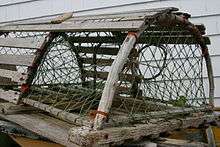

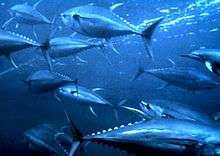
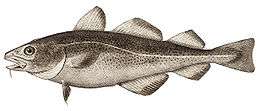
.png)
